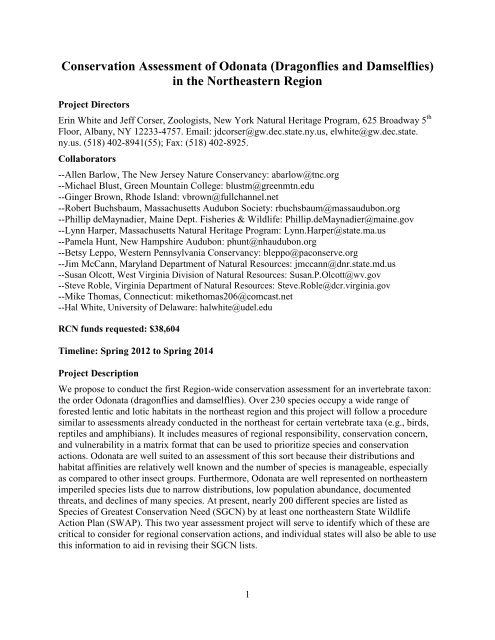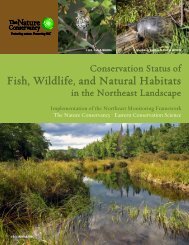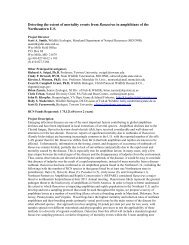Development of Regional Indicators and Measures - (RCN) Program
Development of Regional Indicators and Measures - (RCN) Program
Development of Regional Indicators and Measures - (RCN) Program
Create successful ePaper yourself
Turn your PDF publications into a flip-book with our unique Google optimized e-Paper software.
Conservation Assessment <strong>of</strong> Odonata (Dragonflies <strong>and</strong> Damselflies)<br />
in the Northeastern Region<br />
Project Directors<br />
Erin White <strong>and</strong> Jeff Corser, Zoologists, New York Natural Heritage <strong>Program</strong>, 625 Broadway 5 th<br />
Floor, Albany, NY 12233-4757. Email: jdcorser@gw.dec.state.ny.us, elwhite@gw.dec.state.<br />
ny.us. (518) 402-8941(55); Fax: (518) 402-8925.<br />
Collaborators<br />
--Allen Barlow, The New Jersey Nature Conservancy: abarlow@tnc.org<br />
--Michael Blust, Green Mountain College: blustm@greenmtn.edu<br />
--Ginger Brown, Rhode Isl<strong>and</strong>: vbrown@fullchannel.net<br />
--Robert Buchsbaum, Massachusetts Audubon Society: rbuchsbaum@massaudubon.org<br />
--Phillip deMaynadier, Maine Dept. Fisheries & Wildlife: Phillip.deMaynadier@maine.gov<br />
--Lynn Harper, Massachusetts Natural Heritage <strong>Program</strong>: Lynn.Harper@state.ma.us<br />
--Pamela Hunt, New Hampshire Audubon: phunt@nhaudubon.org<br />
--Betsy Leppo, Western Pennsylvania Conservancy: bleppo@paconserve.org<br />
--Jim McCann, Maryl<strong>and</strong> Department <strong>of</strong> Natural Resources: jmccann@dnr.state.md.us<br />
--Susan Olcott, West Virginia Division <strong>of</strong> Natural Resources: Susan.P.Olcott@wv.gov<br />
--Steve Roble, Virginia Department <strong>of</strong> Natural Resources: Steve.Roble@dcr.virginia.gov<br />
--Mike Thomas, Connecticut: mikethomas206@comcast.net<br />
--Hal White, University <strong>of</strong> Delaware: halwhite@udel.edu<br />
<strong>RCN</strong> funds requested: $38,604<br />
Timeline: Spring 2012 to Spring 2014<br />
Project Description<br />
We propose to conduct the first Region-wide conservation assessment for an invertebrate taxon:<br />
the order Odonata (dragonflies <strong>and</strong> damselflies). Over 230 species occupy a wide range <strong>of</strong><br />
forested lentic <strong>and</strong> lotic habitats in the northeast region <strong>and</strong> this project will follow a procedure<br />
similar to assessments already conducted in the northeast for certain vertebrate taxa (e.g., birds,<br />
reptiles <strong>and</strong> amphibians). It includes measures <strong>of</strong> regional responsibility, conservation concern,<br />
<strong>and</strong> vulnerability in a matrix format that can be used to prioritize species <strong>and</strong> conservation<br />
actions. Odonata are well suited to an assessment <strong>of</strong> this sort because their distributions <strong>and</strong><br />
habitat affinities are relatively well known <strong>and</strong> the number <strong>of</strong> species is manageable, especially<br />
as compared to other insect groups. Furthermore, Odonata are well represented on northeastern<br />
imperiled species lists due to narrow distributions, low population abundance, documented<br />
threats, <strong>and</strong> declines <strong>of</strong> many species. At present, nearly 200 different species are listed as<br />
Species <strong>of</strong> Greatest Conservation Need (SGCN) by at least one northeastern State Wildlife<br />
Action Plan (SWAP). This two year assessment project will serve to identify which <strong>of</strong> these are<br />
critical to consider for regional conservation actions, <strong>and</strong> individual states will also be able to use<br />
this information to aid in revising their SGCN lists.<br />
1
Background, Need, Goals, <strong>and</strong> Scope<br />
Considerable progress has been made in recent years in the evaluation <strong>of</strong> vertebrate<br />
taxonomic groups from a regional conservation perspective. Partners in Flight <strong>and</strong> the North<br />
American Bird Conservation Initiative have prioritized bird species on both continental <strong>and</strong><br />
regional scales using st<strong>and</strong>ardized criteria beginning in 2001. More recently, Northeast Partners<br />
in Amphibian <strong>and</strong> Reptile Conservation (NEPARC) conducted a similar analysis focusing on the<br />
13 northeastern states, using a combination <strong>of</strong> regional responsibility (the proportion <strong>of</strong> a<br />
species’ overall geographic range in the northeast) <strong>and</strong> conservation concern (the proportion <strong>of</strong><br />
states listing a species as SGCN). The products <strong>of</strong> such an exercise are matrices that position<br />
species in predetermined categories <strong>of</strong> vulnerability <strong>and</strong> responsibility, which helps to prioritize<br />
species in the face <strong>of</strong> limited conservation resources. Few invertebrate taxa have been subjected<br />
to similar comprehensive region-wide assessments, at least in part because the distribution <strong>and</strong><br />
status <strong>of</strong> most invertebrate taxa is poorly known, <strong>and</strong> rarely accessible at a regional scale.<br />
An exception to this data deficiency among invertebrates is the insect order Odonata<br />
(dragonflies <strong>and</strong> damselflies), <strong>of</strong> which over 230 species have been reported in the northeastern<br />
U.S. Interest in these conspicuous insects has been growing since the mid-1990s, resulting in a<br />
much improved underst<strong>and</strong>ing <strong>of</strong> their distributions (Donnelly 2004 a,b,c), status, <strong>and</strong> habitat<br />
relationships. Despite this increased knowledge base, Odonata were treated inconsistently in the<br />
northeast SWAPs (Bried <strong>and</strong> Mazzacano 2010). Although northeast SWAPs were more thorough<br />
than those in the rest <strong>of</strong> the country, there was still wide variation among states which may not<br />
reflect pure conservation need. In the last decade, several northeastern states have instituted<br />
organized statewide surveys with the goal <strong>of</strong> collecting baseline data on distribution, including<br />
Maine (Brunelle <strong>and</strong> deMaynadier 2005), New Hampshire, Rhode Isl<strong>and</strong>, New York (White et<br />
al. 2010), <strong>and</strong> West Virginia. Of the remaining states, Massachusetts, Maryl<strong>and</strong>, Vermont,<br />
Connecticut, New Jersey, <strong>and</strong> Delaware have comprehensive data compiled largely through the<br />
efforts <strong>of</strong> individuals or small groups <strong>of</strong> experts. Only Pennsylvania <strong>and</strong> Virginia have what state<br />
experts consider uneven statewide coverage, <strong>and</strong> even in these states there are considerable<br />
recent aggregated data available.<br />
Notably, <strong>of</strong> the Region’s 230 species, about 87% were listed as SGCN by at least one<br />
SWAP. This high percentage <strong>of</strong> SGCN highlights the need for further refinement <strong>of</strong> the actual<br />
status <strong>of</strong> species in the northeast. To conserve Odonata effectively, we propose to apply<br />
consistent <strong>and</strong> comprehensive criteria across all states to identify which species are most<br />
important regionally as well as the most vulnerable. The resulting prioritization scheme will<br />
serve to direct limited state <strong>and</strong> regional resources toward conservation actions that benefit<br />
Odonata <strong>and</strong> their habitats <strong>and</strong> thereby guide implementation <strong>of</strong> SWAPs. Under <strong>RCN</strong> Topic 2<br />
(Identify High Priority Northeast Species <strong>of</strong> Greatest Conservation Need), we will compile<br />
available status <strong>and</strong> distributional information for all Odonate species in all 13 states in Region 5.<br />
<strong>Regional</strong> responsibility will be evaluated <strong>and</strong> all states within the northeast region will benefit by<br />
having updated information at regional scales on which to base conservation decisions that<br />
benefit Odonates <strong>and</strong> their habitats.<br />
.Objectives, Methods, <strong>and</strong> Timeline<br />
Objective 1: Assess regional responsibility for all species <strong>of</strong> Odonata in the northeast.<br />
2
To achieve this objective we will compile existing distributional data from the northeast<br />
into a common database. This step will involve data requests to all <strong>of</strong> the state partners listed as<br />
collaborators. To the extent possible, we will coordinate this task with the ongoing effort to<br />
develop a comprehensive northeastern invertebrate database (<strong>RCN</strong> grant 2009-11), although in<br />
addition to specimens we intend to incorporate verified photos, published records <strong>and</strong> other<br />
sources where appropriate. Because <strong>of</strong> variation in the extent <strong>and</strong> nature <strong>of</strong> survey effort among<br />
states we plan to conduct this assessment at the county level, with any available finer-scale data<br />
being incorporated as appropriate. Once data have been compiled <strong>and</strong> mapped in ARC GIS, we<br />
will use them to delimit each species’ range in the northeast using polygons, <strong>and</strong> compare this<br />
range to that depicted in the U.S. (or North America as a whole) using Donnelly’s (2004 a,b,c)<br />
range maps. The proportion <strong>of</strong> the overall range that falls within the northeast will inform<br />
“regional responsibility,” <strong>and</strong> can be used to prioritize species based on the extent to which<br />
regional conservation actions will benefit a species versus actions elsewhere. The final step here<br />
will be to develop regional responsibility thresholds (e.g., low, moderate, high) as a means <strong>of</strong><br />
prioritizing species based on this criterion. We will consult with our Odonata expert<br />
collaborators (via email <strong>and</strong> conference call) to help us assign cut-<strong>of</strong>fs for regional responsibility<br />
(i.e., NEPARC used a cut-<strong>of</strong>f <strong>of</strong> 50% <strong>of</strong> the species’ range occurring in the northeast as high<br />
responsibility). We will begin the work on this objective upon receipt <strong>of</strong> the grant, <strong>and</strong> expect it<br />
will be completed by the fall <strong>of</strong> 2012.<br />
Objective 2: Assess the regional vulnerability <strong>of</strong> each species occurring in the northeast.<br />
To achieve this objective we will compile existing data on the vulnerability <strong>of</strong> Odonata<br />
across the northeast. In addition to SGCN status, such data could also include NatureServe State<br />
(S) <strong>and</strong>/or Global (G) rarity ranks, State listing (T&E) status, <strong>and</strong>/or habitat vulnerability<br />
assessments. Because these various vulnerability assessments have been conducted using a<br />
variety <strong>of</strong> methods <strong>and</strong> are not always current, we will develop a straightforward method for<br />
combining available state vulnerability metrics into a single regional vulnerability score for each<br />
species <strong>and</strong> the relevant thresholds (i.e., NEPARC used 25%, 50%, 75% <strong>of</strong> states listing as<br />
SGCN) for regional levels <strong>of</strong> concern. We will begin work on this objective upon receipt <strong>of</strong> the<br />
grant, <strong>and</strong> expect it to be completed by the spring <strong>of</strong> 2013. During 2012 we will organize <strong>and</strong><br />
announce the convening <strong>of</strong> a special working group session to be held at the Northeast <strong>Regional</strong><br />
Meeting <strong>of</strong> the Dragonfly Society <strong>of</strong> the Americas (DSA) in the summer <strong>of</strong> 2013. This annual<br />
event draws about 50 experts <strong>and</strong> enthusiasts, <strong>and</strong> serves as the ideal forum to seek input from<br />
knowledgeable Odonatologists on all elements <strong>of</strong> this project in an academic setting. This<br />
working group session will be organized <strong>and</strong> delivered as a st<strong>and</strong>-alone conference workshop to<br />
be incorporated into the <strong>of</strong>ficial schedule <strong>of</strong> the larger DSA conference. We expect to invite 15<br />
conference participants to spend one day in a classroom setting in order to help us refine our<br />
draft products developed in objectives 1 <strong>and</strong> 2.<br />
Objective 3: Combine responsibility <strong>and</strong> vulnerability into a single prioritization matrix <strong>and</strong><br />
habitat crosswalk.<br />
After the responsibility <strong>and</strong> vulnerability scores have been obtained for all species, <strong>and</strong><br />
thresholds set for both factors, species will be categorized into a two-dimensional responsibilityvulnerability<br />
matrix. The matrix will identify species at both ends <strong>of</strong> the conservation spectrum,<br />
from highest priority (“high vulnerability, high responsibility”) to lowest (“low vulnerability,<br />
low responsibility”). Groupings within the matrix may be associated with different sets <strong>of</strong><br />
conservation actions, but it is not the intent <strong>of</strong> this project to identify particular conservation<br />
3
actions. However, because <strong>of</strong> the large number <strong>of</strong> species present in the region, <strong>and</strong> the<br />
association <strong>of</strong> many <strong>of</strong> them with high water quality, we also propose to assign species to habitat<br />
groupings. Habitat categories will be based on a condensed list from a recently completed<br />
Northeast Habitat Classification under a previous <strong>RCN</strong> grant. Species will be assigned to habitats<br />
based on available data <strong>and</strong> expert knowledge. Such a cross-walk will serve to identify<br />
commonalities both among <strong>and</strong> between Odonata <strong>and</strong> other taxa sharing these habitats. A final<br />
step will be to distribute the final matrix product to Odonata experts within <strong>and</strong> outside the<br />
region for additional peer review, <strong>and</strong> to modify it based on their input. We will begin work on<br />
this objective following completion <strong>of</strong> objectives 1 <strong>and</strong> 2 with final completion anticipated for<br />
the spring <strong>of</strong> 2014.<br />
Outcome<br />
The primary outcome <strong>of</strong> this project will be a comprehensive <strong>and</strong> explicit tool by which<br />
individual Odonates can be prioritized on a regional scale, which can then guide both state <strong>and</strong><br />
regional conservation actions. Supplemental products include: 1) updated region-wide<br />
distribution maps for all 230 species, 2) uniform methods for assessing vulnerability, 3) a habitat<br />
cross-walk <strong>of</strong> Odonata species, <strong>and</strong> 4) a list <strong>of</strong> high-priority aquatic habitats hosting<br />
disproportionate numbers <strong>of</strong> at-risk Odonata. Of these supplemental products, the range maps<br />
will be particularly useful for identifying areas where additional survey work is needed for the<br />
highest priority species.<br />
Literature Cited<br />
Bried, J.T., <strong>and</strong> C.A. Mazzacano. (2010) National review <strong>of</strong> state wildlife action plans for<br />
Odonata species <strong>of</strong> greatest conservation need. Insect Conservation <strong>and</strong> Diversity, 3, 61-<br />
71.<br />
Brunelle, P.M, <strong>and</strong> P. deMayanadier. (2005) Maine damselfly <strong>and</strong> dragonfly survey: a final<br />
report. Maine Department <strong>of</strong> Inl<strong>and</strong> Fisheries <strong>and</strong> Wildlife, Bangor.<br />
Donnelly, T.W. (2004a) Distribution <strong>of</strong> North American Odonata. Part I: Aeshnidae,<br />
Petaluridae, Gomphidae, Cordulegastridae. Bulletin <strong>of</strong> American Odonatology, 7, 61-90.<br />
Donnelly, T.W. (2004b) Distribution <strong>of</strong> North American Odonata. Part II: Macromidae,<br />
Corduliidae, <strong>and</strong> Libellulidae. Bulletin <strong>of</strong> American Odonatology, 8, 1-32.<br />
Donnelley, T.W. (2004c) Distribution <strong>of</strong> North American Odonata. Part III: Calopterygidae,<br />
Lestidae, Coenagrionidae, Protoneuridae, Platysticidae. Bulletin <strong>of</strong> American<br />
Odonatology, 8, 33-99.<br />
White, E.L., J.D. Corser, <strong>and</strong> M.D. Schlesinger. (2010) The New York dragonfly <strong>and</strong> damselfly<br />
survey 2005-2009: the distribution <strong>and</strong> status <strong>of</strong> the Odonates <strong>of</strong> New York. New York<br />
Natural Heritage <strong>Program</strong>, Albany: http://www.dec.ny.gov/animals/31061.html.<br />
4
Qualifications <strong>of</strong> project directors <strong>and</strong> principal collaborators<br />
Jeff Corser received his B.S from SUNY ESF, <strong>and</strong> his M.S. in Forest Ecology from Duke<br />
University. He has worked as a Zoologist for the NY Natural Heritage <strong>Program</strong> since 2005<br />
participating on several teams involved with biodiversity assessments <strong>and</strong> analyses throughout<br />
the state. Prior to arriving at NY Heritage, he worked for USGS as an amphibian ecologist, <strong>and</strong><br />
as a stewardship ecologist for the Tennessee Natural Heritage <strong>Program</strong>. He was a co-author <strong>and</strong><br />
active field researcher on the recently completed New York State Dragonfly <strong>and</strong> Damselfly<br />
Survey, <strong>and</strong> is currently authoring an article for a peer-reviewed journal analyzing the data from<br />
this five-year survey effort.<br />
Erin White received a B.A. in Biology from Kalamazoo College in Kalamazoo, MI, <strong>and</strong> an M.S.<br />
in Conservation Biology from Antioch New Engl<strong>and</strong>. In her current position as a Zoologist with<br />
NY Natural Heritage, she coordinated the statewide New York Dragonfly <strong>and</strong> Damselfly Survey<br />
(2005-2009) from 2006 until the conclusion <strong>of</strong> the project <strong>and</strong> was the lead author on the final<br />
report. She has worked on a variety <strong>of</strong> projects including a Nature Conservancy project to<br />
develop a Freshwater Conservation Blueprint for NYS <strong>and</strong> inventories for rare animals under<br />
State Wildlife Grants projects.<br />
Dr. Pamela Hunt received a B.S. in Biology from Cornell University, an M.A. in Zoology from<br />
the University <strong>of</strong> Montana, <strong>and</strong> a Ph.D. in Biology from Dartmouth College. In her current<br />
position as Senior Conservation Biologist at New Hampshire Audubon, she coordinates the<br />
“New Hampshire Dragonfly Survey,” led the revision <strong>of</strong> New Hampshire’s list <strong>of</strong> Threatened<br />
<strong>and</strong> Endangered Species, serves on the State “Wildlife Action Plan Implementation Team,” <strong>and</strong><br />
coordinates avian research <strong>and</strong> monitoring in New Hampshire in conjunction with regional<br />
efforts.<br />
Dr. Phillip deMaynadier received his B.S. in Natural Resources from the University <strong>of</strong> Michigan<br />
<strong>and</strong> Ph.D. in Wildlife Biology from University <strong>of</strong> Maine. He works as a wildlife biologist for<br />
Maine's Department <strong>of</strong> Inl<strong>and</strong> Fisheries <strong>and</strong> Wildlife, serving as Leader for the Reptile,<br />
Amphibian, <strong>and</strong> Invertebrate Group. Some <strong>of</strong> his recent projects include managing the state’s<br />
program for identifying <strong>and</strong> protecting high value vernal pools, researching the effects <strong>of</strong> road<br />
mortality on endangered turtles, helping coordinate statewide atlasing efforts for butterflies,<br />
dragonflies, amphibians, <strong>and</strong> reptiles, <strong>and</strong> advising l<strong>and</strong>owners <strong>and</strong> l<strong>and</strong> trusts on protection<br />
st<strong>and</strong>ards for rare <strong>and</strong> endangered species.<br />
The other collaborators on the cover page <strong>of</strong> this proposal are listed to indicate the breadth <strong>of</strong><br />
regional participation in this proposed project. All state collaborators have agreed to provide data<br />
<strong>and</strong> expertise in reviewing the products <strong>of</strong> this project. Not listed are several additional Odonata<br />
experts from academia <strong>and</strong> elsewhere who will also play important roles in reviewing this work.<br />
5




